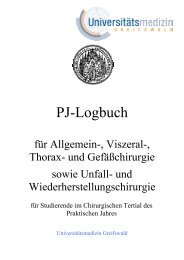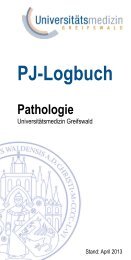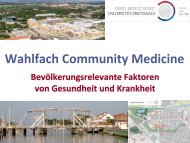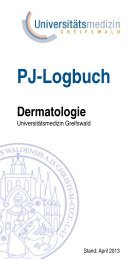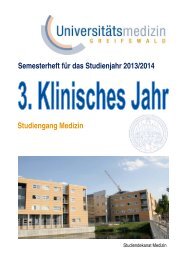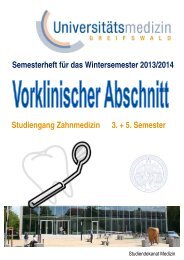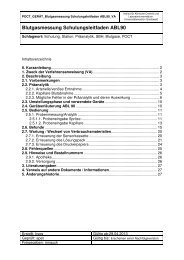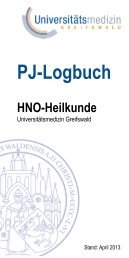Literaturverzeichnis CHI komplett - in der Universitätsmedizin ...
Literaturverzeichnis CHI komplett - in der Universitätsmedizin ...
Literaturverzeichnis CHI komplett - in der Universitätsmedizin ...
Create successful ePaper yourself
Turn your PDF publications into a flip-book with our unique Google optimized e-Paper software.
<strong>Literaturverzeichnis</strong> <strong>CHI</strong> <strong>komplett</strong><br />
1. Abdel Khalek M, Kandil E. Is octreotide safe for the management of persistent<br />
hyper<strong>in</strong>sul<strong>in</strong>emic hypoglycemia of <strong>in</strong>fancy? Eur J Pediatr Surg 2011;21:188-189<br />
2. Abdulhadi-Atwan M, Bushman J, Tornovsky-Babaey S, et al. Novel de novo<br />
mutation <strong>in</strong> sulfonylurea receptor 1 present<strong>in</strong>g as hyper<strong>in</strong>sul<strong>in</strong>ism <strong>in</strong> <strong>in</strong>fancy<br />
followed by overt diabetes <strong>in</strong> early adolescence. Diabetes 2008;57:1935-1940<br />
3. Adzick NS, Thornton PS, Stanley CA, Kaye RD, Ruchelli E. A multidiscipl<strong>in</strong>ary<br />
approach to the focal form of congenital hyper<strong>in</strong>sul<strong>in</strong>ism leads to successful<br />
treatment by partial pancreatectomy. J Pediatr Surg 2004;39:270-275<br />
4. Al-Nassar S, Sakati N, Al-Ashwal A, B<strong>in</strong>-Abbas B. Persistent hyper<strong>in</strong>sul<strong>in</strong>aemic<br />
hypoglycaemia of <strong>in</strong>fancy <strong>in</strong> 43 children: long-term cl<strong>in</strong>ical and surgical follow-up.<br />
Asian J Surg 2006;29:207-211<br />
5. Al-Shanafey S. Laparoscopic vs open pancreatectomy for persistent<br />
hyper<strong>in</strong>sul<strong>in</strong>emic hypoglycemia of <strong>in</strong>fancy. J Pediatr Surg 2009;44:957-961<br />
6. Al-Shanafey S, Alkhudhur H. Food aversion among patients with persistent<br />
hyper<strong>in</strong>sul<strong>in</strong>emic hypoglycemia of <strong>in</strong>fancy. J Pediatr Surg 2012;47:895-897<br />
7. Al-Shanafey S, Habib Z, AlNassar S. Laparoscopic pancreatectomy for persistent<br />
hyper<strong>in</strong>sul<strong>in</strong>emic hypoglycemia of <strong>in</strong>fancy. J Pediatr Surg 2009;44:134-138;<br />
discussion 138<br />
1
8. Anlauf M, Wieben D, Perren A, et al. Persistent hyper<strong>in</strong>sul<strong>in</strong>emic hypoglycemia <strong>in</strong><br />
15 adults with diffuse nesidioblastosis: diagnostic criteria, <strong>in</strong>cidence, and<br />
characterization of beta-cell changes. Am J Surg Pathol 2005;29:524-533<br />
9. Arbizu Lostao J, Fernandez-Marmiesse A, Garrastachu Zumarran P, et al. [18Ffluoro-L-DOPA<br />
PET-CT imag<strong>in</strong>g comb<strong>in</strong>ed with genetic analysis for optimal<br />
classification and treatment <strong>in</strong> a child with severe congenital hyper<strong>in</strong>sul<strong>in</strong>ism]. An<br />
Pediatr (Barc) 2008;68:481-485<br />
10. Arnoux JB, Verkarre V, Sa<strong>in</strong>t-Mart<strong>in</strong> C, et al. Congenital hyper<strong>in</strong>sul<strong>in</strong>ism: current<br />
trends <strong>in</strong> diagnosis and therapy. Orphanet J Rare Dis 2011;6:63<br />
11. Avatapalle B, Padidela R, Randell T, Banerjee I. Drug-<strong>in</strong>duced hepatitis follow<strong>in</strong>g<br />
use of octreotide for long-term treatment of congenital hyper<strong>in</strong>sul<strong>in</strong>ism. BMJ<br />
Case Rep 2012;2012<br />
12. Aynsley-Green A, Hussa<strong>in</strong> K, Hall J, et al. Practical management of<br />
hyper<strong>in</strong>sul<strong>in</strong>ism <strong>in</strong> <strong>in</strong>fancy. Arch Dis Child Fetal Neonatal Ed 2000;82:F98-F107<br />
13. Bakker B, Oostdijk W. Diagnosis and management of congenital hyper<strong>in</strong>sul<strong>in</strong>ism:<br />
a case report. Eur J Endocr<strong>in</strong>ol 2006;155:153-155<br />
14. Balan KK. Visualization of the gall blad<strong>der</strong> on F-18 FDOPA PET imag<strong>in</strong>g: a<br />
potential pitfall. Cl<strong>in</strong> Nucl Med 2005;30:23-24<br />
15. Balasubramaniam S, Kapoor R, Yeow JH, et al. Biochemical evaluation of an<br />
<strong>in</strong>fant with hypoglycemia result<strong>in</strong>g from a novel de novo mutation of the GLUD1<br />
gene and hyper<strong>in</strong>sul<strong>in</strong>ism-hyperammonemia syndrome. J Pediatr Endocr<strong>in</strong>ol<br />
Metab 2011;24:573-577<br />
2
16. Banerjee I, Avatapalle B, Padidela R, et al. Integrat<strong>in</strong>g genetic and imag<strong>in</strong>g<br />
<strong>in</strong>vestigations <strong>in</strong>to the cl<strong>in</strong>ical management of congenital hyper<strong>in</strong>sul<strong>in</strong>ism. Cl<strong>in</strong><br />
Endocr<strong>in</strong>ol (Oxf) 2013;78:803-813<br />
17. Banerjee I, Avatapalle B, Petkar A, et al. The association of cardiac ventricular<br />
hypertrophy with congenital hyper<strong>in</strong>sul<strong>in</strong>ism. Eur J Endocr<strong>in</strong>ol 2012;167:619-624<br />
18. Banerjee I, Skae M, Flanagan SE, et al. The contribution of rapid KATP channel<br />
gene mutation analysis to the cl<strong>in</strong>ical management of children with congenital<br />
hyper<strong>in</strong>sul<strong>in</strong>ism. Eur J Endocr<strong>in</strong>ol 2011;164:733-740<br />
19. Barthlen W. Surgery <strong>in</strong> congenital hyper<strong>in</strong>sul<strong>in</strong>ism-tips and tricks not only for<br />
surgeons. A practical guide. Sem<strong>in</strong> Pediatr Surg 2011;20:56-59<br />
20. Barthlen W. Kalkuliertes Wagnis. Sicherheit und Innovation, Neue Wege neue<br />
Chancen - Techniker Krankenkasse 2012:20-21<br />
21. Barthlen W, Blankenste<strong>in</strong> O, Mau H, et al. Evaluation of [18F]fluoro-L-DOPA<br />
positron emission tomography-computed tomography for surgery <strong>in</strong> focal<br />
congenital hyper<strong>in</strong>sul<strong>in</strong>ism. J Cl<strong>in</strong> Endocr<strong>in</strong>ol Metab 2008;93:869-875<br />
22. Barthlen W, De Lonlay P. Preface. Sem<strong>in</strong> Pediatr Surg 2011;20:1-2<br />
23. Barthlen W, Mohnike K, Müller C. Differentiated Surgical Therapy for Congenital<br />
Hyper<strong>in</strong>sul<strong>in</strong>ism. Pancreatology 2011;11:208<br />
24. Barthlen W, Mohnike W, Mohnike K. Techniques <strong>in</strong> pediatric surgery: congenital<br />
hyper<strong>in</strong>sul<strong>in</strong>ism. Horm Res Paediatr 2011;75:304-310<br />
3
25. Bas VN, Ozkan M, Zenciroglu A, et al. Seizure due to somatostat<strong>in</strong> analog<br />
discont<strong>in</strong>uation <strong>in</strong> a case diagnosed as congenital hyper<strong>in</strong>sul<strong>in</strong>ism novel<br />
mutation. J Pediatr Endocr<strong>in</strong>ol Metab 2012;25:553-555<br />
26. Bax KN, van <strong>der</strong> Zee DC. The laparoscopic approach toward hyper<strong>in</strong>sul<strong>in</strong>ism <strong>in</strong><br />
children. Sem<strong>in</strong> Pediatr Surg 2007;16:245-251<br />
27. Bax NM, van <strong>der</strong> Zee DC, de Vroede M, Jansen M, Nikkels J. Laparoscopic<br />
identification and removal of focal lesions <strong>in</strong> persistent hyper<strong>in</strong>sul<strong>in</strong>emic<br />
hypoglycemia of <strong>in</strong>fancy. Surg Endosc 2003;17:833<br />
28. Bayarchimeg M, Ismail D, Lam A, et al. Galactok<strong>in</strong>ase deficiency <strong>in</strong> a patient with<br />
congenital hyper<strong>in</strong>sul<strong>in</strong>ism. JIMD Rep 2012;5:7-11<br />
29. Bellanne-Chantelot C, Sa<strong>in</strong>t-Mart<strong>in</strong> C, Ribeiro MJ, et al. ABCC8 and KCNJ11<br />
molecular spectrum of 109 patients with diazoxide-unresponsive congenital<br />
hyper<strong>in</strong>sul<strong>in</strong>ism. J Med Genet 2010;47:752-759<br />
30. Beltrand J, Caquard M, Arnoux JB, et al. Glucose metabolism <strong>in</strong> 105 children and<br />
adolescents after pancreatectomy for congenital hyper<strong>in</strong>sul<strong>in</strong>ism. Diabetes Care<br />
2012;35:198-203<br />
31. Ben Turkia H, Brahim K, Azzouz H, et al. Congenital hyper<strong>in</strong>sul<strong>in</strong>ism: review of 12<br />
Tunisian cases. Tunis Med 2011;89:369-373<br />
32. Biagiotti L, Proverbio MC, Bosio L, et al. Identification of two novel frameshift<br />
mutations <strong>in</strong> the KCNJ11 gene <strong>in</strong> two Italian patients affected by Congenital<br />
Hyper<strong>in</strong>sul<strong>in</strong>ism of Infancy. Exp Mol Pathol 2007;83:59-64<br />
4
33. Blakely ML, Lobe TE, Cohen J, Burghen GA. Laparoscopic pancreatectomy for<br />
persistent hyper<strong>in</strong>sul<strong>in</strong>emic hypoglycemia of <strong>in</strong>fancy. Surg Endosc 2001;15:897-<br />
898<br />
34. Bowman P, Flanagan SE, Edghill EL, et al. Heterozygous ABCC8 mutations are a<br />
cause of MODY. Diabetologia 2011;55:123-127<br />
35. Branstrom R, Berglund E, Curman P, et al. Electrical short-circuit <strong>in</strong> beta-cells<br />
from a patient with non-<strong>in</strong>sul<strong>in</strong>oma pancreatogenous hypoglycemic syndrome<br />
(NIPHS): a case report. J Med Case Rep 2010;4:315<br />
36. Bremer AA, Nobuhara KK, Gitelman SE. Congenital hyper<strong>in</strong>sul<strong>in</strong>ism <strong>in</strong> an <strong>in</strong>fant<br />
caused by a macroscopic <strong>in</strong>sul<strong>in</strong>-produc<strong>in</strong>g lesion. J Pediatr Endocr<strong>in</strong>ol Metab<br />
2007;20:437-440<br />
37. Brunelle F, Negre V, Barth MO, et al. Pancreatic venous sampl<strong>in</strong>gs <strong>in</strong> <strong>in</strong>fants and<br />
children with primary hyper<strong>in</strong>sul<strong>in</strong>ism. Pediatr Radiol 1989;19:100-103<br />
38. Brunetti-Pierri N, Olutoye OO, Heptulla R, Tatevian N. Case report: pathological<br />
features of aberrant pancreatic development <strong>in</strong> congenital hyper<strong>in</strong>sul<strong>in</strong>ism due to<br />
ABCC8 mutations. Ann Cl<strong>in</strong> Lab Sci 2008;38:386-389<br />
39. Bulbul A, Bolat F, Comert S, et al. Persistent hyper<strong>in</strong>sul<strong>in</strong>emic hypoglycemia with<br />
left ventricular hypertrophy and dysrhythmia: a case report. Fetal Pediatr Pathol<br />
2010;29:165-171<br />
40. Burns CM, Rutherford MA, Boardman JP, Cowan FM. Patterns of cerebral <strong>in</strong>jury<br />
and neurodevelopmental outcomes after symptomatic neonatal hypoglycemia.<br />
Pediatrics 2008;122:65-74<br />
5
41. Capito C, de Lonlay P, Verkarre V, et al. The surgical management of atypical<br />
forms of congenital hyper<strong>in</strong>sul<strong>in</strong>ism. Sem<strong>in</strong> Pediatr Surg 2011;20:54-55<br />
42. Capito C, Khen-Dunlop N, Ribeiro MJ, et al. Value of 18F-fluoro-L-dopa PET <strong>in</strong> the<br />
preoperative localization of focal lesions <strong>in</strong> congenital hyper<strong>in</strong>sul<strong>in</strong>ism. Radiology<br />
2009;253:216-222<br />
43. Casanova D, Polavieja MG, Naranjo A, et al. Surgical treatment of persistent<br />
hyper<strong>in</strong>sul<strong>in</strong>emic hypoglycemia (PHH) (<strong>in</strong>sul<strong>in</strong>oma and nesidioblastosis).<br />
Langenbecks Arch Surg 2007;392:663-670<br />
44. Cherian MP, Abduljabbar MA. Persistent hyper<strong>in</strong>sul<strong>in</strong>emic hypoglycemia of<br />
<strong>in</strong>fancy (PHHI): Long-term outcome follow<strong>in</strong>g 95% pancreatectomy. J Pediatr<br />
Endocr<strong>in</strong>ol Metab 2005;18:1441-1448<br />
45. Cherub<strong>in</strong>i V, Bagal<strong>in</strong>i LS, Ianilli A, et al. Rapid genetic analysis, imag<strong>in</strong>g with 18F-<br />
DOPA-PET/CT scan and laparoscopic surgery <strong>in</strong> congenital hyper<strong>in</strong>sul<strong>in</strong>ism. J<br />
Pediatr Endocr<strong>in</strong>ol Metab 2010;23:171-177<br />
46. Chigot V, De Lonlay P, Nassogne MC, et al. Pancreatic arterial calcium stimulation<br />
<strong>in</strong> the diagnosis and localisation of persistent hyper<strong>in</strong>sul<strong>in</strong>emic hypoglycaemia of<br />
<strong>in</strong>fancy. Pediatr Radiol 2001;31:650-655<br />
47. Chik KK, Chan CW, Lam CW, Ng KL. Hyper<strong>in</strong>sul<strong>in</strong>ism and hyperammonaemia<br />
syndrome due to a novel missense mutation <strong>in</strong> the allosteric doma<strong>in</strong> of the<br />
glutamate dehydrogenase 1 gene. J Paediatr Child Health 2008;44:517-519<br />
48. Christesen HB, Brusgaard K, Alm J, et al. Rapid genetic analysis <strong>in</strong> congenital<br />
hyper<strong>in</strong>sul<strong>in</strong>ism. Horm Res 2007;67:184-188<br />
6
49. Christesen HB, Tribble ND, Molven A, et al. Activat<strong>in</strong>g glucok<strong>in</strong>ase (GCK)<br />
mutations as a cause of medically responsive congenital hyper<strong>in</strong>sul<strong>in</strong>ism:<br />
prevalence <strong>in</strong> children and characterisation of a novel GCK mutation. Eur J<br />
Endocr<strong>in</strong>ol 2008;159:27-34<br />
50. Christesen HT, Brusgaard K, Hussa<strong>in</strong> K. Recurrent spontaneous hypoglycaemia<br />
causes loss of neurogenic and neuroglycopaenic signs <strong>in</strong> <strong>in</strong>fants with congenital<br />
hyper<strong>in</strong>sul<strong>in</strong>ism. Cl<strong>in</strong> Endocr<strong>in</strong>ol (Oxf) 2011;76:548-554<br />
51. Correa-Giannella ML, Freire DS, Cavaleiro AM, et al.<br />
Hyper<strong>in</strong>sul<strong>in</strong>ism/hyperammonemia (HI/HA) syndrome due to a mutation <strong>in</strong> the<br />
glutamate dehydrogenase gene. Arq Bras Endocr<strong>in</strong>ol Metabol 2012;56:485-489<br />
52. Cosgrove KE, Anto<strong>in</strong>e MH, Lee AT, et al. BPDZ 154 activates adenos<strong>in</strong>e 5'-<br />
triphosphate-sensitive potassium channels: <strong>in</strong> vitro studies us<strong>in</strong>g rodent <strong>in</strong>sul<strong>in</strong>secret<strong>in</strong>g<br />
cells and islets isolated from patients with hyper<strong>in</strong>sul<strong>in</strong>ism. J Cl<strong>in</strong><br />
Endocr<strong>in</strong>ol Metab 2002;87:4860-4868<br />
53. Cosgrove KE, Shepherd RM, Fernandez EM, et al. Genetics and pathophysiology<br />
of hyper<strong>in</strong>sul<strong>in</strong>ism <strong>in</strong> <strong>in</strong>fancy. Horm Res 2004;61:270-288<br />
54. Cosgrove KE, Straub SG, Barnes PD, et al. Y-26763: ATP-sensitive K+ channel<br />
activation and the <strong>in</strong>hibition of <strong>in</strong>sul<strong>in</strong> release from human pancreatic beta-cells.<br />
Eur J Pharmacol 2004;486:133-139<br />
55. Craver RD, Hill CB. Cure of hypoglycemic hyper<strong>in</strong>sul<strong>in</strong>ism by enucleation of a<br />
focal islet cell adenomatous hyperplasia. J Pediatr Surg 1997;32:1526-1527<br />
56. Cretolle C, de Lonlay P, Sauvat F, et al. [Congenital hyper<strong>in</strong>sul<strong>in</strong>ism of <strong>in</strong>fancy:<br />
surgical treatment <strong>in</strong> 60 cases of focal form]. Arch Pediatr 2005;12:258-263<br />
7
57. Cretolle C, Fekete CN, Jan D, et al. Partial elective pancreatectomy is curative <strong>in</strong><br />
focal form of permanent hyper<strong>in</strong>sul<strong>in</strong>emic hypoglycaemia <strong>in</strong> <strong>in</strong>fancy: A report of<br />
45 cases from 1983 to 2000. J Pediatr Surg 2002;37:155-158<br />
58. Dacou-Voutetakis C, Psychou F, Maniati-Christidis M. Persistent hyper<strong>in</strong>sul<strong>in</strong>emic<br />
hypoglycemia of <strong>in</strong>fancy: long-term results. J Pediatr Endocr<strong>in</strong>ol Metab 1998;11<br />
Suppl 1:131-141<br />
59. Damaj L, le Lorch M, Verkarre V, et al. Chromosome 11p15 paternal isodisomy <strong>in</strong><br />
focal forms of neonatal hyper<strong>in</strong>sul<strong>in</strong>ism. J Cl<strong>in</strong> Endocr<strong>in</strong>ol Metab 2008;93:4941-<br />
4947<br />
60. De Leon DD, Li C, Delson MI, et al. Exend<strong>in</strong>-(9-39) corrects fast<strong>in</strong>g hypoglycemia<br />
<strong>in</strong> SUR-1-/- mice by lower<strong>in</strong>g cAMP <strong>in</strong> pancreatic beta-cells and <strong>in</strong>hibit<strong>in</strong>g <strong>in</strong>sul<strong>in</strong><br />
secretion. J Biol Chem 2008;283:25786-25793<br />
61. De Leon DD, Stanley CA. Mechanisms of Disease: advances <strong>in</strong> diagnosis and<br />
treatment of hyper<strong>in</strong>sul<strong>in</strong>ism <strong>in</strong> neonates. Nat Cl<strong>in</strong> Pract Endocr<strong>in</strong>ol Metab<br />
2007;3:57-68<br />
62. de Lonlay P, Fournet JC, Rahier J, et al. Somatic deletion of the impr<strong>in</strong>ted 11p15<br />
region <strong>in</strong> sporadic persistent hyper<strong>in</strong>sul<strong>in</strong>emic hypoglycemia of <strong>in</strong>fancy is specific<br />
of focal adenomatous hyperplasia and endorses partial pancreatectomy. J Cl<strong>in</strong><br />
Invest 1997;100:802-807<br />
63. de Lonlay P, Fournet JC, Touati G, et al. Heterogeneity of persistent<br />
hyper<strong>in</strong>sul<strong>in</strong>aemic hypoglycaemia. A series of 175 cases. Eur J Pediatr<br />
2002;161:37-48<br />
64. de Lonlay P, Giurgea I, Sempoux C, et al. Dom<strong>in</strong>antly <strong>in</strong>herited hyper<strong>in</strong>sul<strong>in</strong>aemic<br />
hypoglycaemia. J Inherit Metab Dis 2005;28:267-276<br />
8
65. de Lonlay P, Giurgea I, Touati G, Saudubray JM. Neonatal hypoglycaemia:<br />
aetiologies. Sem<strong>in</strong> Neonatol 2004;9:49-58<br />
66. de Lonlay P, Simon-Carre A, Ribeiro MJ, et al. Congenital hyper<strong>in</strong>sul<strong>in</strong>ism:<br />
pancreatic [18F]fluoro-L-dihydroxyphenylalan<strong>in</strong>e (DOPA) positron emission<br />
tomography and immunohistochemistry study of DOPA decarboxylase and <strong>in</strong>sul<strong>in</strong><br />
secretion. J Cl<strong>in</strong> Endocr<strong>in</strong>ol Metab 2006;91:933-940<br />
67. de Lonlay-Debeney P, Poggi-Travert F, Fournet JC, et al. Cl<strong>in</strong>ical features of 52<br />
neonates with hyper<strong>in</strong>sul<strong>in</strong>ism. N Engl J Med 1999;340:1169-1175<br />
68. De Vroede M, Bax NM, Brusgaard K, Dunne MJ, Groenendaal F. Laparoscopic<br />
diagnosis and cure of hyper<strong>in</strong>sul<strong>in</strong>ism <strong>in</strong> two cases of focal adenomatous<br />
hyperplasia <strong>in</strong> <strong>in</strong>fancy. Pediatrics 2004;114:e520-522<br />
69. Dekelbab BH, Sperl<strong>in</strong>g MA. Recent advances <strong>in</strong> hyper<strong>in</strong>sul<strong>in</strong>emic hypoglycemia of<br />
<strong>in</strong>fancy. Acta Paediatr 2006;95:1157-1164<br />
70. Delonlay P, Simon A, Galmiche-Rolland L, et al. Neonatal hyper<strong>in</strong>sul<strong>in</strong>ism:<br />
cl<strong>in</strong>icopathologic correlation. Hum Pathol 2007;38:387-399<br />
71. Dissanayake AS, Jones V, Fernando DJ. Adult hyper<strong>in</strong>sul<strong>in</strong>aemic hypoglycaemia<br />
caused by coexist<strong>in</strong>g nesidioblastosis and <strong>in</strong>sul<strong>in</strong>oma. Eur J Intern Med<br />
2008;19:303<br />
72. Dubois J, Brunelle F, Touati G, et al. Hyper<strong>in</strong>sul<strong>in</strong>ism <strong>in</strong> children: diagnostic value<br />
of pancreatic venous sampl<strong>in</strong>g correlated with cl<strong>in</strong>ical, pathological and surgical<br />
outcome <strong>in</strong> 25 cases. Pediatr Radiol 1995;25:512-516<br />
9
73. Dunne MJ, Cosgrove KE, Shepherd RM, Aynsley-Green A, L<strong>in</strong>dley KJ.<br />
Hyper<strong>in</strong>sul<strong>in</strong>ism <strong>in</strong> <strong>in</strong>fancy: from basic science to cl<strong>in</strong>ical disease. Physiol Rev<br />
2004;84:239-275<br />
74. Eichmann D, Hufnagel M, Quick P, Santer R. Treatment of hyper<strong>in</strong>sul<strong>in</strong>aemic<br />
hypoglycaemia with nifedip<strong>in</strong>e. Eur J Pediatr 1999;158:204-206<br />
75. Faletra F, Sni<strong>der</strong> K, Shyng SL, et al. Co-<strong>in</strong>heritance of two ABCC8 mutations<br />
caus<strong>in</strong>g an unresponsive congenital hyper<strong>in</strong>sul<strong>in</strong>ism: cl<strong>in</strong>ical and functional<br />
characterization of two novel ABCC8 mutations. Gene 2012;516:122-125<br />
76. Fekete CN, de Lonlay P, Jaubert F, et al. The surgical management of congenital<br />
hyper<strong>in</strong>sul<strong>in</strong>emic hypoglycemia <strong>in</strong> <strong>in</strong>fancy. J Pediatr Surg 2004;39:267-269<br />
77. Fernandez-Alvarez JR, Rabe H, Wilichowski E, Pekrun A. Pitfalls bei <strong>der</strong> Diagnose<br />
des kongenitalen Hyper<strong>in</strong>sul<strong>in</strong>ismus: E<strong>in</strong> Fallbericht und Übersicht <strong>der</strong> Literatur.<br />
Kl<strong>in</strong> Pädiatr 2006;218:233-236<br />
78. Flanagan SE, Kapoor RR, Banerjee I, et al. Dom<strong>in</strong>antly act<strong>in</strong>g ABCC8 mutations <strong>in</strong><br />
patients with medically unresponsive hyper<strong>in</strong>sul<strong>in</strong>aemic hypoglycaemia. Cl<strong>in</strong><br />
Genet 2011;79:582-587<br />
79. Flanagan SE, Kapoor RR, Hussa<strong>in</strong> K. Genetics of congenital hyper<strong>in</strong>sul<strong>in</strong>emic<br />
hypoglycemia. Sem<strong>in</strong> Pediatr Surg 2011;20:13-17<br />
80. Flanagan SE, Kapoor RR, Mali G, et al. Diazoxide-responsive hyper<strong>in</strong>sul<strong>in</strong>emic<br />
hypoglycemia caused by HNF4A gene mutations. Eur J Endocr<strong>in</strong>ol 2010;162:987-<br />
992<br />
10
81. Flanagan SE, Xie W, Caswell R, et al. Next-generation sequenc<strong>in</strong>g reveals deep<br />
<strong>in</strong>tronic cryptic ABCC8 and HADH splic<strong>in</strong>g foun<strong>der</strong> mutations caus<strong>in</strong>g<br />
hyper<strong>in</strong>sul<strong>in</strong>ism by pseudoexon activation. Am J Hum Genet 2013;92:131-136<br />
82. Fournet JC, Mayaud C, de Lonlay P, et al. Unbalanced expression of 11p15<br />
impr<strong>in</strong>ted genes <strong>in</strong> focal forms of congenital hyper<strong>in</strong>sul<strong>in</strong>ism: association with a<br />
reduction to homozygosity of a mutation <strong>in</strong> ABCC8 or KCNJ11. Am J Pathol<br />
2001;158:2177-2184<br />
83. Fourtner SH, Stanley CA, Kelly A. Prote<strong>in</strong>-sensitive hypoglycemia without leuc<strong>in</strong>e<br />
sensitivity <strong>in</strong> hyper<strong>in</strong>sul<strong>in</strong>ism caused by K(ATP) channel mutations. J Pediatr<br />
2006;149:47-52<br />
84. Girard CA, Wun<strong>der</strong>lich FT, Shimomura K, et al. Expression of an activat<strong>in</strong>g<br />
mutation <strong>in</strong> the gene encod<strong>in</strong>g the KATP channel subunit Kir6.2 <strong>in</strong> mouse<br />
pancreatic beta cells recapitulates neonatal diabetes. J Cl<strong>in</strong> Invest 2009;119:80-<br />
90<br />
85. Giurgea I, Bellanne-Chantelot C, Ribeiro M, et al. Molecular mechanisms of<br />
neonatal hyper<strong>in</strong>sul<strong>in</strong>ism. Horm Res 2006;66:289-296<br />
86. Giurgea I, Laborde K, Touati G, et al. Acute <strong>in</strong>sul<strong>in</strong> responses to calcium and<br />
tolbutamide do not differentiate focal from diffuse congenital hyper<strong>in</strong>sul<strong>in</strong>ism. J<br />
Cl<strong>in</strong> Endocr<strong>in</strong>ol Metab 2004;89:925-929<br />
87. Giurgea I, Ribeiro MJ, Boddaert N, et al. [Congenital hyper<strong>in</strong>sul<strong>in</strong>ism <strong>in</strong> newborn<br />
and <strong>in</strong>fant]. Arch Pediatr 2005;12:1628-1635<br />
88. Giurgea I, Sanlaville D, Fournet JC, et al. Congenital hyper<strong>in</strong>sul<strong>in</strong>ism and mosaic<br />
abnormalities of the ploidy. J Med Genet 2006;43:248-254<br />
11
89. Giurgea I, Sempoux C, Bellanne-Chantelot C, et al. The Knudson's two-hit model<br />
and tim<strong>in</strong>g of somatic mutation may account for the phenotypic diversity of focal<br />
congenital hyper<strong>in</strong>sul<strong>in</strong>ism. J Cl<strong>in</strong> Endocr<strong>in</strong>ol Metab 2006;91:4118-4123<br />
90. Giurgea I, Ul<strong>in</strong>ski T, Touati G, et al. Factitious hyper<strong>in</strong>sul<strong>in</strong>ism lead<strong>in</strong>g to<br />
pancreatectomy: severe forms of Munchausen syndrome by proxy. Pediatrics<br />
2005;116:e145-148<br />
91. Glaser B. Lessons <strong>in</strong> human biology from a monogenic pancreatic beta cell<br />
disease. J Cl<strong>in</strong> Invest 2011;121:3821-3825<br />
92. Glaser B, Blech I, Krak<strong>in</strong>ovsky Y, et al. ABCC8 mutation allele frequency <strong>in</strong> the<br />
Ashkenazi Jewish population and risk of focal hyper<strong>in</strong>sul<strong>in</strong>emic hypoglycemia.<br />
Genet Med 2011<br />
93. Glaser B, Hirsch HJ, Landau H. Persistent hyper<strong>in</strong>sul<strong>in</strong>emic hypoglycemia of<br />
<strong>in</strong>fancy: long-term octreotide treatment without pancreatectomy. J Pediatr<br />
1993;123:644-650<br />
94. Goh BK, Ooi LL, Cheow PC, et al. Accurate preoperative localization of<br />
<strong>in</strong>sul<strong>in</strong>omas avoids the need for bl<strong>in</strong>d resection and reoperation: analysis of a<br />
s<strong>in</strong>gle <strong>in</strong>stitution experience with 17 surgically treated tumors over 19 years. J<br />
Gastro<strong>in</strong>test Surg 2009;13:1071-1077<br />
95. Gonzalez-Barroso MM, Giurgea I, Bouillaud F, et al. Mutations <strong>in</strong> UCP2 <strong>in</strong><br />
congenital hyper<strong>in</strong>sul<strong>in</strong>ism reveal a role for regulation of <strong>in</strong>sul<strong>in</strong> secretion. PLoS<br />
One 2008;3:e3850<br />
96. Goossens A, Gepts W, Saudubray JM, et al. Diffuse and focal nesidioblastosis. A<br />
cl<strong>in</strong>icopathological study of 24 patients with persistent neonatal hyper<strong>in</strong>sul<strong>in</strong>emic<br />
hypoglycemia. Am J Surg Pathol 1989;13:766-775<br />
12
97. Greer RM, Shah J, Jeske YW, et al. Genotype-phenotype associations <strong>in</strong> patients<br />
with severe hyper<strong>in</strong>sul<strong>in</strong>ism of <strong>in</strong>fancy. Pediatr Dev Pathol 2007;10:25-34<br />
98. Gruppuso PA, DeLuca F, O'Shea PA, Schwartz R. Near-total pancreatectomy for<br />
hyper<strong>in</strong>sul<strong>in</strong>ism. Spontaneous remission of resultant diabetes. Acta Paediatr<br />
Scand 1985;74:311-315<br />
99. Guerrero-Fernandez J, Gonzalez Casado I, Esp<strong>in</strong>oza Col<strong>in</strong>dres L, Gracia<br />
Bouthelier R. [Congenital hyper<strong>in</strong>sul<strong>in</strong>ism. Review of 22 cases]. An Pediatr (Barc)<br />
2006;65:22-31<br />
100. Guss<strong>in</strong>yer M, Clemente M, Cebrian R, et al. Glucose <strong>in</strong>tolerance and diabetes are<br />
observed <strong>in</strong> the long-term follow-up of nonpancreatectomized patients with<br />
persistent hyper<strong>in</strong>sul<strong>in</strong>emic hypoglycemia of <strong>in</strong>fancy due to mutations <strong>in</strong> the<br />
ABCC8 gene. Diabetes Care 2008;31:1257-1259<br />
101. Hardy OT, Hernandez-Pampaloni M, Saffer JR, et al. Accuracy of [18F]fluorodopa<br />
positron emission tomography for diagnos<strong>in</strong>g and localiz<strong>in</strong>g focal congenital<br />
hyper<strong>in</strong>sul<strong>in</strong>ism. J Cl<strong>in</strong> Endocr<strong>in</strong>ol Metab 2007;92:4706-4711<br />
102. Hardy OT, Hernandez-Pampaloni M, Saffer JR, et al. Diagnosis and localization of<br />
focal congenital hyper<strong>in</strong>sul<strong>in</strong>ism by 18F-fluorodopa PET scan. J Pediatr<br />
2007;150:140-145<br />
103. Hardy OT, Hohmeier HE, Becker TC, et al. Functional genomics of the beta-cell:<br />
short-cha<strong>in</strong> 3-hydroxyacyl-coenzyme A dehydrogenase regulates <strong>in</strong>sul<strong>in</strong> secretion<br />
<strong>in</strong>dependent of K+ currents. Mol Endocr<strong>in</strong>ol 2007;21:765-773<br />
104. Henqu<strong>in</strong> JC, Nenqu<strong>in</strong> M, Sempoux C, et al. In vitro <strong>in</strong>sul<strong>in</strong> secretion by pancreatic<br />
tissue from <strong>in</strong>fants with diazoxide-resistant congenital hyper<strong>in</strong>sul<strong>in</strong>ism deviates<br />
from model predictions. J Cl<strong>in</strong> Invest 2011;121:3932-3942<br />
13
105. Henqu<strong>in</strong> JC, Rahier J. Pancreatic alpha cell mass <strong>in</strong> European subjects with type<br />
2 diabetes. Diabetologia 2011;54:1720-1725<br />
106. Henqu<strong>in</strong> JC, Sempoux C, Marchandise J, et al. Congenital hyper<strong>in</strong>sul<strong>in</strong>ism caused<br />
by hexok<strong>in</strong>ase I expression or glucok<strong>in</strong>ase-activat<strong>in</strong>g mutation <strong>in</strong> a subset of<br />
beta-cells. Diabetes 2012;62:1689-1696<br />
107. Henwood MJ, Kelly A, Macmullen C, et al. Genotype-phenotype correlations <strong>in</strong><br />
children with congenital hyper<strong>in</strong>sul<strong>in</strong>ism due to recessive mutations of the<br />
adenos<strong>in</strong>e triphosphate-sensitive potassium channel genes. J Cl<strong>in</strong> Endocr<strong>in</strong>ol<br />
Metab 2005;90:789-794<br />
108. Hu S, Xu Z, Yan J, et al. The treatment effect of diazoxide on 44 patients with<br />
congenital hyper<strong>in</strong>sul<strong>in</strong>ism. J Pediatr Endocr<strong>in</strong>ol Metab 2012;25:1119-1122<br />
109. Huang T, Kelly A, Becker SA, Cohen MS, Stanley CA. Hypertrophic<br />
cardiomyopathy <strong>in</strong> neonates with congenital hyper<strong>in</strong>sul<strong>in</strong>ism. Arch Dis Child Fetal<br />
Neonatal Ed 2013;98:F351-354<br />
110. Hufnagel M, Eichmann D, Stieh J, Santer R. Further evidence for a dom<strong>in</strong>ant<br />
form of familial persistent hyper<strong>in</strong>sul<strong>in</strong>emic hypoglycemia of <strong>in</strong>fancy: a family<br />
with documented hyper<strong>in</strong>sul<strong>in</strong>emia <strong>in</strong> two generations. J Cl<strong>in</strong> Endocr<strong>in</strong>ol Metab<br />
1998;83:2215-2216<br />
111. Huopio H, Otonkoski T, Vauhkonen I, et al. A new subtype of autosomal<br />
dom<strong>in</strong>ant diabetes attributable to a mutation <strong>in</strong> the gene for sulfonylurea<br />
receptor 1. Lancet 2003;361:301-307<br />
112. Hussa<strong>in</strong> K. Congenital hyper<strong>in</strong>sul<strong>in</strong>ism. Sem<strong>in</strong> Fetal Neonatal Med 2005;10:369-<br />
376<br />
14
113. Hussa<strong>in</strong> K. Diagnosis and management of hyper<strong>in</strong>sul<strong>in</strong>aemic hypoglycaemia of<br />
<strong>in</strong>fancy. Horm Res 2008;69:2-13<br />
114. Hussa<strong>in</strong> K. Congenital hyper<strong>in</strong>sul<strong>in</strong>ism and neonatal diabetes mellitus. Rev<br />
Endocr Metab Disord 2010;11:155-156<br />
115. Hussa<strong>in</strong> K. Investigations for neonatal hypoglycaemia. Cl<strong>in</strong> Biochem<br />
2011;44:465-466<br />
116. Hussa<strong>in</strong> K, Bitner-Gl<strong>in</strong>dzicz M, Blaydon D, et al. Infantile hyper<strong>in</strong>sul<strong>in</strong>ism<br />
associated with enteropathy, deafness and renal tubulopathy: cl<strong>in</strong>ical<br />
manifestations of a syndrome caused by a contiguous gene deletion located on<br />
chromosome 11p. J Pediatr Endocr<strong>in</strong>ol Metab 2004;17:1613-1621<br />
117. Hussa<strong>in</strong> K, Bryan J, Christesen HT, Brusgaard K, Aguilar-Bryan L. Serum<br />
glucagon counterregulatory hormonal response to hypoglycemia is blunted <strong>in</strong><br />
congenital hyper<strong>in</strong>sul<strong>in</strong>ism. Diabetes 2005;54:2946-2951<br />
118. Hussa<strong>in</strong> K, Cosgrove KE. From congenital hyper<strong>in</strong>sul<strong>in</strong>ism to diabetes mellitus:<br />
the role of pancreatic beta-cell KATP channels. Pediatr Diabetes 2005;6:103-113<br />
119. Hussa<strong>in</strong> K, Cosgrove KE, Shepherd RM, et al. Hyper<strong>in</strong>sul<strong>in</strong>emic hypoglycemia <strong>in</strong><br />
Beckwith-Wiedemann syndrome due to defects <strong>in</strong> the function of pancreatic<br />
beta-cell adenos<strong>in</strong>e triphosphate-sensitive potassium channels. J Cl<strong>in</strong> Endocr<strong>in</strong>ol<br />
Metab 2005;90:4376-4382<br />
120. Hussa<strong>in</strong> K, Flanagan SE, Smith VV, et al. An ABCC8 gene mutation and mosaic<br />
uniparental isodisomy result<strong>in</strong>g <strong>in</strong> atypical diffuse congenital hyper<strong>in</strong>sul<strong>in</strong>ism.<br />
Diabetes 2008;57:259-263<br />
15
121. Hussa<strong>in</strong> K, Seppanen M, Nanto-Salonen K, et al. The diagnosis of ectopic focal<br />
hyper<strong>in</strong>sul<strong>in</strong>ism of <strong>in</strong>fancy with [18F]-dopa positron emission tomography. J Cl<strong>in</strong><br />
Endocr<strong>in</strong>ol Metab 2006;91:2839-2842<br />
122. Ismail D, Kapoor RR, Smith V, et al. The Heterogeneity of Focal Forms of<br />
Congenital Hyper<strong>in</strong>sul<strong>in</strong>ism. J Cl<strong>in</strong> Endocr<strong>in</strong>ol Metab 2012;97:E0000-E0000<br />
123. Ismail D, Smith VV, de Lonlay P, et al. Familial focal congenital hyper<strong>in</strong>sul<strong>in</strong>ism. J<br />
Cl<strong>in</strong> Endocr<strong>in</strong>ol Metab 2011;96:24-28<br />
124. Ismail D, Werther G. Persistent hyper<strong>in</strong>sul<strong>in</strong>aemic hypoglycaemia of <strong>in</strong>fancy: 15<br />
years' experience at the Royal Children's Hospital (RCH), Melbourne. J Pediatr<br />
Endocr<strong>in</strong>ol Metab 2005;18:1103-1109<br />
125. Jack MM, Greer RM, Thomsett MJ, et al. The outcome <strong>in</strong> Australian children with<br />
hyper<strong>in</strong>sul<strong>in</strong>ism of <strong>in</strong>fancy: early extensive surgery <strong>in</strong> severe cases lowers risk of<br />
diabetes. Cl<strong>in</strong> Endocr<strong>in</strong>ol (Oxf) 2003;58:355-364<br />
126. Jack MM, Walker RM, Thomsett MJ, Cotterill AM, Bell JR. Histologic f<strong>in</strong>d<strong>in</strong>gs <strong>in</strong><br />
persistent hyper<strong>in</strong>sul<strong>in</strong>emic hypoglycemia of <strong>in</strong>fancy: Australian experience.<br />
Pediatr Dev Pathol 2000;3:532-547<br />
127. James C, Kapoor RR, Ismail D, Hussa<strong>in</strong> K. The genetic basis of congenital<br />
hyper<strong>in</strong>sul<strong>in</strong>ism. J Med Genet 2009;46:289-299<br />
128. Johnson D, Shepherd RM, Gill D, et al. Glucose-dependent modulation of <strong>in</strong>sul<strong>in</strong><br />
secretion and <strong>in</strong>tracellular calcium ions by GKA50, a glucok<strong>in</strong>ase activator.<br />
Diabetes 2007;56:1694-1702<br />
129. Kaczirek K, Nie<strong>der</strong>le B. Nesidioblastosis: an old term and a new un<strong>der</strong>stand<strong>in</strong>g.<br />
World J Surg 2004;28:1227-1230<br />
16
130. Kane C, L<strong>in</strong>dley KJ, Johnson PR, et al. Therapy for persistent hyper<strong>in</strong>sul<strong>in</strong>emic<br />
hypoglycemia of <strong>in</strong>fancy. Un<strong>der</strong>stand<strong>in</strong>g the responsiveness of beta cells to<br />
diazoxide and somatostat<strong>in</strong>. J Cl<strong>in</strong> Invest 1997;100:1888-1893<br />
131. Kane C, Shepherd RM, Squires PE, et al. Loss of functional KATP channels <strong>in</strong><br />
pancreatic beta-cells causes persistent hyper<strong>in</strong>sul<strong>in</strong>emic hypoglycemia of <strong>in</strong>fancy.<br />
Nat Med 1996;2:1344-1347<br />
132. Kapoor RR, Flanagan SE, Arya VB, et al. Cl<strong>in</strong>ical and molecular characterisation of<br />
300 patients with congenital hyper<strong>in</strong>sul<strong>in</strong>ism. Eur J Endocr<strong>in</strong>ol 2013;168:557-564<br />
133. Kapoor RR, Flanagan SE, Ellard S, Hussa<strong>in</strong> K. Congenital hyper<strong>in</strong>sul<strong>in</strong>ism: marked<br />
cl<strong>in</strong>ical heterogeneity <strong>in</strong> sibl<strong>in</strong>gs with identical mutations <strong>in</strong> the ABCC8 gene. Cl<strong>in</strong><br />
Endocr<strong>in</strong>ol (Oxf) 2011;76:312-313<br />
134. Kapoor RR, Flanagan SE, Fulton P, et al. Hyper<strong>in</strong>sul<strong>in</strong>ism-hyperammonaemia<br />
syndrome: novel mutations <strong>in</strong> the GLUD1 gene and genotype-phenotype<br />
correlations. Eur J Endocr<strong>in</strong>ol 2009;161:731-735<br />
135. Kapoor RR, Flanagan SE, James C, et al. Hyper<strong>in</strong>sul<strong>in</strong>aemic hypoglycaemia. Arch<br />
Dis Child 2009;94:450-457<br />
136. Kapoor RR, Gilbert C, Mohnike K, et al. Congenital hyper<strong>in</strong>sul<strong>in</strong>ism: [18F]DOPA<br />
PET/CT scan of a focal lesion <strong>in</strong> the head of the pancreas. Arch Dis Child Fetal<br />
Neonatal Ed 2008;93:F166<br />
137. Kapoor RR, James C, Flanagan SE, et al. 3-Hydroxyacyl-coenzyme A<br />
dehydrogenase deficiency and hyper<strong>in</strong>sul<strong>in</strong>emic hypoglycemia: characterization<br />
of a novel mutation and severe dietary prote<strong>in</strong> sensitivity. J Cl<strong>in</strong> Endocr<strong>in</strong>ol Metab<br />
2009;94:2221-2225<br />
17
138. Kapoor RR, James C, Hussa<strong>in</strong> K. Advances <strong>in</strong> the diagnosis and management of<br />
hyper<strong>in</strong>sul<strong>in</strong>emic hypoglycemia. Nat Cl<strong>in</strong> Pract Endocr<strong>in</strong>ol Metab 2009;5:101-112<br />
139. Kapoor RR, James C, Hussa<strong>in</strong> K. Hyper<strong>in</strong>sul<strong>in</strong>ism <strong>in</strong> developmental syndromes.<br />
Endocr Dev 2009;14:95-113<br />
140. Kassem SA, Ariel I, Thornton PS, et al. p57(KIP2) expression <strong>in</strong> normal islet cells<br />
and <strong>in</strong> hyper<strong>in</strong>sul<strong>in</strong>ism of <strong>in</strong>fancy. Diabetes 2001;50:2763-2769<br />
141. Kassem SA, Ariel I, Thornton PS, Scheimberg I, Glaser B. Beta-cell proliferation<br />
and apoptosis <strong>in</strong> the develop<strong>in</strong>g normal human pancreas and <strong>in</strong> hyper<strong>in</strong>sul<strong>in</strong>ism<br />
of <strong>in</strong>fancy. Diabetes 2000;49:1325-1333<br />
142. Kauhanen S, Seppanen M, M<strong>in</strong>n H, et al. Fluor<strong>in</strong>e-18-L-dihydroxyphenylalan<strong>in</strong>e<br />
(18F-DOPA) positron emission tomography as a tool to localize an <strong>in</strong>sul<strong>in</strong>oma or<br />
beta-cell hyperplasia <strong>in</strong> adult patients. J Cl<strong>in</strong> Endocr<strong>in</strong>ol Metab 2007;92:1237-<br />
1244<br />
143. Kelly A, Tang R, Becker S, Stanley CA. Poor specificity of low growth hormone<br />
and cortisol levels dur<strong>in</strong>g fast<strong>in</strong>g hypoglycemia for the diagnoses of growth<br />
hormone deficiency and adrenal <strong>in</strong>sufficiency. Pediatrics 2008;122:e522-528<br />
144. Kenney B, Tormey CA, Q<strong>in</strong> L, et al. Adult nesidioblastosis. Cl<strong>in</strong>icopathologic<br />
correlation between pre-operative selective arterial calcium stimulation studies<br />
and post-operative pathologic f<strong>in</strong>d<strong>in</strong>gs. JOP 2008;9:504-511<br />
145. Khen-Dunlop N, Capito C, Valayannopoulos V, et al. Predictive value of<br />
postoperative glycosuria after partial elective pancreatectomy <strong>in</strong> focal congenital<br />
hyper<strong>in</strong>sul<strong>in</strong>ism. Diabetes Care 2008;31:e71<br />
18
146. Kloppel G, Anlauf M, Raffel A, Perren A, Knoefel WT. Adult diffuse<br />
nesidioblastosis: genetically or environmentally <strong>in</strong>duced? Hum Pathol 2008;39:3-<br />
8<br />
147. Knudson AG, Jr. Mutation and cancer: statistical study of ret<strong>in</strong>oblastoma. Proc<br />
Natl Acad Sci U S A 1971;68:820-823<br />
148. Koren I, Risk<strong>in</strong> A, Barthlen W, Gillis D. Hepatitis <strong>in</strong> an <strong>in</strong>fant treated with<br />
octreotide for congenital hyper<strong>in</strong>sul<strong>in</strong>ism. J Pediatr Endocr Met 2013;26:183-185<br />
149. Kork F, Blankenste<strong>in</strong> O, Mohnike W, Höhne C. Sedierung von K<strong>in</strong><strong>der</strong>n zum PET-<br />
CT bei kongenitalem Hyper<strong>in</strong>sul<strong>in</strong>ismus. Anaesthesist 2008;57:1087-1090<br />
150. Kubota A, Yonekura T, Usui N, et al. Two cases of persistent hyper<strong>in</strong>sul<strong>in</strong>emic<br />
hypoglycemia that showed spontaneous regression and maturation of the<br />
Langerhans islets. J Pediatr Surg 2000;35:1661-1662<br />
151. Kuhnen P, Marquard J, Ernert A, et al. Long-term lanreotide treatment <strong>in</strong> six<br />
patients with congenital hyper<strong>in</strong>sul<strong>in</strong>ism. Horm Res Paediatr 2012;78:106-112<br />
152. Kumaran A, Kapoor RR, Flanagan SE, Ellard S, Hussa<strong>in</strong> K. Congenital<br />
hyper<strong>in</strong>sul<strong>in</strong>ism due to a compound heterozygous ABCC8 mutation with<br />
spontaneous resolution at eight weeks. Horm Res Paediatr 2010;73:287-292<br />
153. Kushner JA, Simpson L, Wartschow LM, et al. Phosphatase and tens<strong>in</strong> homolog<br />
regulation of islet growth and glucose homeostasis. J Biol Chem<br />
2005;280:39388-39393<br />
154. Laje P, Halaby L, Adzick NS, Stanley CA. Necrotiz<strong>in</strong>g enterocolitis <strong>in</strong> neonates<br />
receiv<strong>in</strong>g octreotide for the management of congenital hyper<strong>in</strong>sul<strong>in</strong>ism. Pediatr<br />
Diabetes 2009;11:142-147<br />
19
155. Langer P, Bartsch DK, Fendrich V, et al. [M<strong>in</strong>imal-<strong>in</strong>vasive operative treatment of<br />
organic hyper<strong>in</strong>sul<strong>in</strong>ism]. Dtsch Med Wochenschr 2005;130:514-518<br />
156. Le Quan Sang KH, Arnoux JB, Mamoune A, et al. Successful treatment of<br />
congenital hyper<strong>in</strong>sul<strong>in</strong>ism with long-act<strong>in</strong>g release octreotide. Eur J Endocr<strong>in</strong>ol<br />
2011;166:333-339<br />
157. Leibowitz G, Kaiser N, Cerasi E. Balanc<strong>in</strong>g needs and means: the dilemma of the<br />
beta-cell <strong>in</strong> the mo<strong>der</strong>n world. Diabetes Obes Metab 2009;11 Suppl 4:1-9<br />
158. Leibowitz G, We<strong>in</strong>trob N, Pikarsky A, et al. Normal pro<strong>in</strong>sul<strong>in</strong> process<strong>in</strong>g despite<br />
beta-cell dysfunction <strong>in</strong> persistent hyper<strong>in</strong>sul<strong>in</strong>aemic hypoglycaemia of <strong>in</strong>fancy<br />
(nesidioblastosis). Diabetologia 1996;39:1338-1344<br />
159. Levitt Katz LE, Sat<strong>in</strong>-Smith MS, Collett-Solberg P, et al. Insul<strong>in</strong>-like growth factor<br />
b<strong>in</strong>d<strong>in</strong>g prote<strong>in</strong>-1 levels <strong>in</strong> the diagnosis of hypoglycemia caused by<br />
hyper<strong>in</strong>sul<strong>in</strong>ism. J Pediatr 1997;131:193-199<br />
160. Liem NT, Son TN, Hoan NT. Laparoscopic near-total pancreatectomy for<br />
persistent hyper<strong>in</strong>sul<strong>in</strong>emic hypoglycemia of <strong>in</strong>fancy: report of two cases. J<br />
Laparoendosc Adv Surg Tech A 2010;20:115-117<br />
161. Liew CG, Moore H, Ruban L, et al. Human embryonic stem cells: possibilities for<br />
human cell transplantation. Ann Med 2005;37:521-532<br />
162. Liew CG, Shah NN, Briston SJ, et al. PAX4 enhances beta-cell differentiation of<br />
human embryonic stem cells. PLoS One 2008;3:e1783<br />
163. Limongelli P, Belli A, Cioffi L, et al. Hepatobiliary and pancreatic: nesidioblastosis.<br />
J Gastroenterol Hepatol 2012;27:1538<br />
20
164. L<strong>in</strong> YW, Bushman JD, Yan FF, et al. Destabilization of ATP-sensitive potassium<br />
channel activity by novel KCNJ11 mutations identified <strong>in</strong> congenital<br />
hyper<strong>in</strong>sul<strong>in</strong>ism. J Biol Chem 2008;283:9146-9156<br />
165. L<strong>in</strong> YW, MacMullen C, Ganguly A, Stanley CA, Shyng SL. A novel KCNJ11<br />
mutation associated with congenital hyper<strong>in</strong>sul<strong>in</strong>ism reduces the <strong>in</strong>tr<strong>in</strong>sic open<br />
probability of beta-cell ATP-sensitive potassium channels. J Biol Chem<br />
2006;281:3006-3012<br />
166. L<strong>in</strong>dley KJ, Dunne MJ. Contemporary strategies <strong>in</strong> the diagnosis and<br />
management of neonatal hyper<strong>in</strong>sul<strong>in</strong>aemic hypoglycaemia. Early Hum Dev<br />
2005;81:61-72<br />
167. L<strong>in</strong>dley KJ, Spitz L. Surgery of persistent hyper<strong>in</strong>sul<strong>in</strong>aemic hypoglycaemia.<br />
Sem<strong>in</strong> Neonatol 2003;8:259-265<br />
168. Lovisolo SM, Mendonca BB, P<strong>in</strong>to EM, et al. Congenital hyper<strong>in</strong>sul<strong>in</strong>ism <strong>in</strong><br />
Brazilian neonates: a study of histology, KATP channel genes, and proliferation of<br />
beta cells. Pediatr Dev Pathol 2010;13:375-384<br />
169. Ludwig A, Ziegenhorn K, Empt<strong>in</strong>g S, et al. Glucose metabolism and neurological<br />
outcome <strong>in</strong> congenital hyper<strong>in</strong>sul<strong>in</strong>ism. Sem<strong>in</strong> Pediatr Surg 2011;20:45-49<br />
170. Macmullen CM, Zhou Q, Sni<strong>der</strong> KE, et al. Diazoxide-unresponsive congenital<br />
hyper<strong>in</strong>sul<strong>in</strong>ism <strong>in</strong> children with dom<strong>in</strong>ant mutations of the beta-cell sulfonylurea<br />
receptor SUR1. Diabetes 2011;60:1797-1804<br />
171. Mannikko R, Flanagan SE, Sim X, et al. Mutations of the same conserved<br />
glutamate residue <strong>in</strong> NBD2 of the sulfonylurea receptor 1 subunit of the KATP<br />
channel can result <strong>in</strong> either hyper<strong>in</strong>sul<strong>in</strong>ism or neonatal diabetes. Diabetes<br />
2011;60:1813-1822<br />
21
172. Marhfour I, Moul<strong>in</strong> P, Marchandise J, et al. Impact of Sur1 gene <strong>in</strong>activation on<br />
the morphology of mouse pancreatic endocr<strong>in</strong>e tissue. Cell Tissue Res<br />
2009;335:505-515<br />
173. Marquard J, Pallad<strong>in</strong>o AA, Stanley CA, Mayatepek E, Meissner T. Rare forms of<br />
congenital hyper<strong>in</strong>sul<strong>in</strong>ism. Sem<strong>in</strong> Pediatr Surg 2011<br />
174. 20:38-44<br />
175. Mart<strong>in</strong>ac I, Bogovic M, Bat<strong>in</strong>ica S, et al. [Congenital hyper<strong>in</strong>sul<strong>in</strong>ism--novel<br />
<strong>in</strong>sights <strong>in</strong>to etiology, diagnosis and treatment]. Lijec Vjesn 2012;134:286-292<br />
176. Mart<strong>in</strong>ez-Ibanez V, Guss<strong>in</strong>yer M, Toran N, et al. Pancreatectomy extension <strong>in</strong><br />
persistent hyper<strong>in</strong>sul<strong>in</strong>aemic hypoglycaemia: a new strategy. Eur J Pediatr Surg<br />
2002;12:262-266<br />
177. Masue M, Nishibori H, Fukuyama S, et al. Diagnostic accuracy of [(1)(8)F]-fluoro-<br />
L-dihydroxyphenylalan<strong>in</strong>e positron emission tomography scan for persistent<br />
congenital hyper<strong>in</strong>sul<strong>in</strong>ism <strong>in</strong> Japan. Cl<strong>in</strong> Endocr<strong>in</strong>ol (Oxf) 2011;75:342-346<br />
178. Mazor-Aronovitch K, Gillis D, Lobel D, et al. Long-term neurodevelopmental<br />
outcome <strong>in</strong> conservatively treated congenital hyper<strong>in</strong>sul<strong>in</strong>ism. Eur J Endocr<strong>in</strong>ol<br />
2007;157:491-497<br />
179. Mazor-Aronovitch K, Landau H, Gillis D. Surgical versus non-surgical treatment of<br />
congenital hyper<strong>in</strong>sul<strong>in</strong>ism. Pediatr Endocr<strong>in</strong>ol Rev 2009;6:424-430<br />
180. Meissner T, Be<strong>in</strong>brech B, Mayatepek E. Congenital hyper<strong>in</strong>sul<strong>in</strong>ism: molecular<br />
basis of a heterogeneous disease. Hum Mutat 1999;13:351-361<br />
22
181. Meissner T, Brune W, Mayatepek E. Persistent hyper<strong>in</strong>sul<strong>in</strong>aemic hypoglycaemia<br />
of <strong>in</strong>fancy: therapy, cl<strong>in</strong>ical outcome and mutational analysis. Eur J Pediatr<br />
1997;156:754-757<br />
182. Meissner T, Friedmann B, Okun JG, et al. Massive <strong>in</strong>sul<strong>in</strong> secretion <strong>in</strong> response to<br />
anaerobic exercise <strong>in</strong> exercise-<strong>in</strong>duced hyper<strong>in</strong>sul<strong>in</strong>ism. Horm Metab Res<br />
2005;37:690-694<br />
183. Meissner T, Marquard J, Cobo-Vuilleumier N, et al. Diagnostic difficulties <strong>in</strong><br />
glucok<strong>in</strong>ase hyper<strong>in</strong>sul<strong>in</strong>ism. Horm Metab Res 2009;41:320-326<br />
184. Meissner T, Mayatepek E. Cl<strong>in</strong>ical and genetic heterogeneity <strong>in</strong> congenital<br />
hyper<strong>in</strong>sul<strong>in</strong>ism. Eur J Pediatr 2002;161:6-20<br />
185. Meissner T, Mayatepek E, K<strong>in</strong>ner M, Santer R. Ur<strong>in</strong>ary alpha-ketoglutarate is<br />
elevated <strong>in</strong> patients with hyper<strong>in</strong>sul<strong>in</strong>ism-hyperammonemia syndrome. Cl<strong>in</strong> Chim<br />
Acta 2004;341:23-26<br />
186. Meissner T, Otonkoski T, Feneberg R, et al. Exercise <strong>in</strong>duced hypoglycaemic<br />
hyper<strong>in</strong>sul<strong>in</strong>ism. Arch Dis Child 2001;84:254-257<br />
187. Meissner T, Rabl W, Mohnike K, et al. Hyper<strong>in</strong>sul<strong>in</strong>ism <strong>in</strong> syndromal disor<strong>der</strong>s.<br />
Acta Paediatr 2001;90:856-859<br />
188. Meissner T, Wendel U, Burgard P, Schaetzle S, Mayatepek E. Long-term followup<br />
of 114 patients with congenital hyper<strong>in</strong>sul<strong>in</strong>ism. Eur J Endocr<strong>in</strong>ol<br />
2003;149:43-51<br />
189. Menni F, de Lonlay P, Sev<strong>in</strong> C, et al. Neurologic outcomes of 90 neonates and<br />
<strong>in</strong>fants with persistent hyper<strong>in</strong>sul<strong>in</strong>emic hypoglycemia. Pediatrics 2001;107:476-<br />
479<br />
23
190. Mercimek-Mahmutoglu S, Rami B, Feucht M, et al. Long-term follow-up of<br />
patients with congenital hyper<strong>in</strong>sul<strong>in</strong>ism <strong>in</strong> Austria. J Pediatr Endocr<strong>in</strong>ol Metab<br />
2008;21:523-532<br />
191. Modan-Moses D, Koren I, Mazor-Aronovitch K, P<strong>in</strong>has-Hamiel O, Landau H.<br />
Treatment of congenital hyper<strong>in</strong>sul<strong>in</strong>ism with lanreotide acetate (Somatul<strong>in</strong>e<br />
Autogel). J Cl<strong>in</strong> Endocr<strong>in</strong>ol Metab 2011;96:2312-2317<br />
192. Mohnike K, Blankenste<strong>in</strong> O, Christesen HT, et al. Proposal for a standardized<br />
protocol for 18F-DOPA-PET (PET/CT) <strong>in</strong> congenital hyper<strong>in</strong>sul<strong>in</strong>ism. Horm Res<br />
2006;66:40-42<br />
193. Mohnike K, Blankenste<strong>in</strong> O, M<strong>in</strong>n H, et al. [18F]-DOPA positron emission<br />
tomography for preoperative localization <strong>in</strong> congenital hyper<strong>in</strong>sul<strong>in</strong>ism. Horm Res<br />
2008;70:65-72<br />
194. Mohnike K, Blankenste<strong>in</strong> O, Pfuetzner A, et al. Long-term non-surgical therapy of<br />
severe persistent congenital hyper<strong>in</strong>sul<strong>in</strong>ism with glucagon. Horm Res<br />
2008;70:59-64<br />
195. Mohnike K, Starke I, Bannert N, Heise HR. [Differential diagnosis and therapy of<br />
hypoglycemia <strong>in</strong> childhood]. K<strong>in</strong><strong>der</strong>arztl Prax 1993;61:192-201<br />
196. Mohnike W, Barthlen W, Mohnike K, Blankenste<strong>in</strong> O. Positron emission<br />
tomography/computed tomography diagnostics by means of fluor<strong>in</strong>e-18-Ldihydroxyphenylalan<strong>in</strong>e<br />
<strong>in</strong> congenital hyper<strong>in</strong>sul<strong>in</strong>ism. Sem<strong>in</strong> Pediatr Surg<br />
2011;20:23-27<br />
197. Morgillo D, Berger T, Caduff J, et al. Congenital hyper<strong>in</strong>sul<strong>in</strong>ism. Swiss Society of<br />
Neonatology 2012<br />
24
198. Negri G, Puglisi A, Gerev<strong>in</strong>i S, Voci C, Zann<strong>in</strong>i P. Thoracoscopic techniques <strong>in</strong> the<br />
management of benign mediast<strong>in</strong>al dumbbell tumors. Surg Endosc 2001;15:897<br />
199. Obatake M, Mochizuki K, Taura Y, et al. Pancreatic head resection preserv<strong>in</strong>g the<br />
ma<strong>in</strong> pancreatic duct for congenital hyper<strong>in</strong>sul<strong>in</strong>ism of <strong>in</strong>fancy. Pediatr Surg Int<br />
2012;28:935-937<br />
200. Ocal G, Flanagan SE, Hacihamdioglu B, et al. Cl<strong>in</strong>ical characteristics of recessive<br />
and dom<strong>in</strong>ant congenital hyper<strong>in</strong>sul<strong>in</strong>ism due to mutation(s) <strong>in</strong> the<br />
ABCC8/KCNJ11 genes encod<strong>in</strong>g the ATP-sensitive potasium channel <strong>in</strong> the<br />
pancreatic beta cell. J Pediatr Endocr<strong>in</strong>ol Metab 2011;24:1019-1023<br />
201. Okabayashi T, Shima Y, Sumiyoshi T, et al. Diagnosis and management of<br />
<strong>in</strong>sul<strong>in</strong>oma. World J Gastroenterol 2013;19:829-837<br />
202. Otonkoski T, Kam<strong>in</strong>en N, Ust<strong>in</strong>ov J, et al. Physical exercise-<strong>in</strong>duced<br />
hyper<strong>in</strong>sul<strong>in</strong>emic hypoglycemia is an autosomal-dom<strong>in</strong>ant trait characterized by<br />
abnormal pyruvate-<strong>in</strong>duced <strong>in</strong>sul<strong>in</strong> release. Diabetes 2003;52:199-204<br />
203. Otonkoski T, Nanto-Salonen K, Seppanen M, et al. Non<strong>in</strong>vasive diagnosis of focal<br />
hyper<strong>in</strong>sul<strong>in</strong>ism of <strong>in</strong>fancy with [18F]-DOPA positron emission tomography.<br />
Diabetes 2006;55:13-18<br />
204. Ouyang D, Dhall D, Yu R. Pathologic pancreatic endocr<strong>in</strong>e cell hyperplasia. World<br />
J Gastroenterol 2011;17:137-143<br />
205. Pallad<strong>in</strong>o AA, Bennett MJ, Stanley CA. Hyper<strong>in</strong>sul<strong>in</strong>ism <strong>in</strong> <strong>in</strong>fancy and childhood:<br />
when an <strong>in</strong>sul<strong>in</strong> level is not always enough. Cl<strong>in</strong> Chem 2008;54:256-263<br />
25
206. Pallad<strong>in</strong>o AA, Stanley CA. A specialized team approach to diagnosis and medical<br />
versus surgical treatment of <strong>in</strong>fants with congenital hyper<strong>in</strong>sul<strong>in</strong>ism. Sem<strong>in</strong><br />
Pediatr Surg 2011;20:32-37<br />
207. Park SE, Flanagan SE, Hussa<strong>in</strong> K, et al. Characterization of ABCC8 and KCNJ11<br />
gene mutations and phenotypes <strong>in</strong> Korean patients with congenital<br />
hyper<strong>in</strong>sul<strong>in</strong>ism. Eur J Endocr<strong>in</strong>ol 2011;164:919-926<br />
208. Patterson ME, Mao CS, Yeh MW, et al. Hyper<strong>in</strong>sul<strong>in</strong>ism present<strong>in</strong>g <strong>in</strong> childhood<br />
and treatment by conservative pancreatectomy. Endocr Pract 2012;18:e52-56<br />
209. Peranteau WH, Bathaii SM, Pawel B, et al. Multiple ectopic lesions of focal islet<br />
adenomatosis identified by positron emission tomography scan <strong>in</strong> an <strong>in</strong>fant with<br />
congenital hyper<strong>in</strong>sul<strong>in</strong>ism. J Pediatr Surg 2007;42:188-192<br />
210. Peranteau WH, Ganguly A, Ste<strong>in</strong>muller L, et al. Prenatal diagnosis and postnatal<br />
management of diffuse congenital hyper<strong>in</strong>sul<strong>in</strong>ism: a case report. Fetal Diagn<br />
Ther 2006;21:515-518<br />
211. Petrik J, Pell JM, Arany E, et al. Overexpression of <strong>in</strong>sul<strong>in</strong>-like growth factor-II <strong>in</strong><br />
transgenic mice is associated with pancreatic islet cell hyperplasia. Endocr<strong>in</strong>ology<br />
1999;140:2353-2363<br />
212. Pierro A, Nah SA. Surgical management of congenital hyper<strong>in</strong>sul<strong>in</strong>ism of <strong>in</strong>fancy.<br />
Sem<strong>in</strong> Pediatr Surg 2011;20:50-53<br />
213. P<strong>in</strong>ney SE, MacMullen C, Becker S, et al. Cl<strong>in</strong>ical characteristics and biochemical<br />
mechanisms of congenital hyper<strong>in</strong>sul<strong>in</strong>ism associated with dom<strong>in</strong>ant KATP<br />
channel mutations. J Cl<strong>in</strong> Invest 2008;118:2877-2886<br />
26
214. Placzkowski KA, Vella A, Thompson GB, et al. Secular trends <strong>in</strong> the presentation<br />
and management of function<strong>in</strong>g <strong>in</strong>sul<strong>in</strong>oma at the Mayo Cl<strong>in</strong>ic, 1987-2007. J Cl<strong>in</strong><br />
Endocr<strong>in</strong>ol Metab 2009;94:1069-1073<br />
215. Powell PD, Bellanne-Chantelot C, Flanagan SE, et al. In vitro recovery of ATPsensitive<br />
potassium channels <strong>in</strong> beta-cells from patients with congenital<br />
hyper<strong>in</strong>sul<strong>in</strong>ism of <strong>in</strong>fancy. Diabetes 2011;60:1223-1228<br />
216. Pratt EB, Yan FF, Gay JW, Stanley CA, Shyng SL. Sulfonylurea receptor 1<br />
mutations that cause opposite <strong>in</strong>sul<strong>in</strong> secretion defects with chemical chaperone<br />
exposure. J Biol Chem 2009;284:7951-7959<br />
217. Proks P, Ashcroft FM. Model<strong>in</strong>g K(ATP) channel gat<strong>in</strong>g and its regulation. Prog<br />
Biophys Mol Biol 2009;99:7-19<br />
218. Przybylik-Mazurek E, Pach D, Hubalewska-Dydejczyk A, et al. [Symptoms and<br />
early diagnostic possibilities of pancreatic endocr<strong>in</strong>e cells hyperplasia<br />
(nesidioblastosis)]. Przegl Lek 2012;69:9-14<br />
219. Quan Y, Barszczyk A, Feng ZP, Sun HS. Current un<strong>der</strong>stand<strong>in</strong>g of K ATP channels<br />
<strong>in</strong> neonatal diseases: focus on <strong>in</strong>sul<strong>in</strong> secretion disor<strong>der</strong>s. Acta Pharmacol S<strong>in</strong><br />
2011;32:765-780<br />
220. Rahier J, Guiot Y, Sempoux C. Persistent hyper<strong>in</strong>sul<strong>in</strong>aemic hypoglycaemia of<br />
<strong>in</strong>fancy: a heterogeneous syndrome unrelated to nesidioblastosis. Arch Dis Child<br />
Fetal Neonatal Ed 2000;82:F108-112<br />
221. Rahier J, Guiot Y, Sempoux C. Morphologic analysis of focal and diffuse forms of<br />
congenital hyper<strong>in</strong>sul<strong>in</strong>ism. Sem<strong>in</strong> Pediatr Surg 2011;20:3-12<br />
27
222. Rahier J, Sempoux C, Fournet JC, et al. Partial or near-total pancreatectomy for<br />
persistent neonatal hyper<strong>in</strong>sul<strong>in</strong>aemic hypoglycaemia: the pathologist's role.<br />
Histopathology 1998;32:15-19<br />
223. Ribeiro MJ, Boddaert N, Bellanne-Chantelot C, et al. The added value of<br />
[18F]fluoro-L-DOPA PET <strong>in</strong> the diagnosis of hyper<strong>in</strong>sul<strong>in</strong>ism of <strong>in</strong>fancy: a<br />
retrospective study <strong>in</strong>volv<strong>in</strong>g 49 children. Eur J Nucl Med Mol Imag<strong>in</strong>g<br />
2007;34:2120-2128<br />
224. Ribeiro MJ, Boddaert N, Delzescaux T, et al. Functional imag<strong>in</strong>g of the pancreas:<br />
the role of [18F]fluoro-L-DOPA PET <strong>in</strong> the diagnosis of hyper<strong>in</strong>sul<strong>in</strong>ism of <strong>in</strong>fancy.<br />
Endocr Dev 2007;12:55-66<br />
225. Ribeiro MJ, De Lonlay P, Delzescaux T, et al. Characterization of hyper<strong>in</strong>sul<strong>in</strong>ism<br />
<strong>in</strong> <strong>in</strong>fancy assessed with PET and 18F-fluoro-L-DOPA. J Nucl Med 2005;46:560-<br />
566<br />
226. Rother KI, Matsumoto JM, Rasmussen NH, Schwenk WF. Subtotal<br />
pancreatectomy for hypoglycemia due to congenital hyper<strong>in</strong>sul<strong>in</strong>ism: long-term<br />
follow-up of neurodevelopmental and pancreatic function. Pediatr Diabetes<br />
2001;2:115-122<br />
227. Ruan W, Lai M. Insul<strong>in</strong>-like growth factor b<strong>in</strong>d<strong>in</strong>g prote<strong>in</strong>: a possible marker for<br />
the metabolic syndrome? Acta Diabetol;47:5-14<br />
228. Sa<strong>in</strong>t-Mart<strong>in</strong> C, Arnoux JB, de Lonlay P, Bellanne-Chantelot C. KATP channel<br />
mutations <strong>in</strong> congenital hyper<strong>in</strong>sul<strong>in</strong>ism. Sem<strong>in</strong> Pediatr Surg 2011;20:18-22<br />
229. Sandal T, Laborie LB, Brusgaard K, et al. The spectrum of ABCC8 mutations <strong>in</strong><br />
Norwegian patients with congenital hyper<strong>in</strong>sul<strong>in</strong>ism of <strong>in</strong>fancy. Cl<strong>in</strong> Genet<br />
2009;75:440-448<br />
28
230. Santer R, Hoffmann H, Suttorp M, Simeoni E, Schaub J. Discordance for<br />
hyper<strong>in</strong>sul<strong>in</strong>emic hypoglycemia <strong>in</strong> monozygotic tw<strong>in</strong>s. J Pediatr 1995;126:1017<br />
231. Santer R, K<strong>in</strong>ner M, Passarge M, et al. Novel missense mutations outside the<br />
allosteric doma<strong>in</strong> of glutamate dehydrogenase are prevalent <strong>in</strong> European patients<br />
with the congenital hyper<strong>in</strong>sul<strong>in</strong>ism-hyperammonemia syndrome. Hum Genet<br />
2001;108:66-71<br />
232. Scott-Coombes D, Eatock F, Henley R, Luzio SD. Use of <strong>in</strong>traoperative <strong>in</strong>sul<strong>in</strong><br />
assay for the localisation of <strong>in</strong>sul<strong>in</strong>oma. World J Surg 2009;33:969-971<br />
233. Sempoux C, Capito C, Bellanne-Chantelot C, et al. Morphological Mosaicism of<br />
the Pancreatic Islets: A Novel Anatomopathological Form of Persistent<br />
Hyper<strong>in</strong>sul<strong>in</strong>emic Hypoglycemia of Infancy. J Cl<strong>in</strong> Endocr<strong>in</strong>ol Metab 2011<br />
234. Sempoux C, Guiot Y, Dahan K, et al. The focal form of persistent<br />
hyper<strong>in</strong>sul<strong>in</strong>emic hypoglycemia of <strong>in</strong>fancy: morphological and molecular studies<br />
show structural and functional differences with <strong>in</strong>sul<strong>in</strong>oma. Diabetes<br />
2003;52:784-794<br />
235. Sempoux C, Guiot Y, Lefevre A, et al. Neonatal hyper<strong>in</strong>sul<strong>in</strong>emic hypoglycemia:<br />
heterogeneity of the syndrome and keys for differential diagnosis. J Cl<strong>in</strong><br />
Endocr<strong>in</strong>ol Metab 1998;83:1455-1461<br />
236. Sempoux C, Guiot Y, Rahier J. The focal form of persistent hyper<strong>in</strong>sul<strong>in</strong>emic<br />
hypoglycemia of <strong>in</strong>fancy. Diabetes 2001;50 Suppl 1:S182-183<br />
237. Service FJ, Nathan DM, Mul<strong>der</strong> JE. Nonislet cell tumor hypoglycemia. In:<br />
UpToDate ed; 2011<br />
29
238. Service FJ, Natt N, Thompson GB, et al. Non<strong>in</strong>sul<strong>in</strong>oma pancreatogenous<br />
hypoglycemia: a novel syndrome of hyper<strong>in</strong>sul<strong>in</strong>emic hypoglycemia <strong>in</strong> adults<br />
<strong>in</strong>dependent of mutations <strong>in</strong> Kir6.2 and SUR1 genes. J Cl<strong>in</strong> Endocr<strong>in</strong>ol Metab<br />
1999;84:1582-1589<br />
239. Service GJ, Thompson GB, Service FJ, et al. Hyper<strong>in</strong>sul<strong>in</strong>emic hypoglycemia with<br />
nesidioblastosis after gastric-bypass surgery. N Engl J Med 2005;353:249-254<br />
240. Shemer R, Avnon Ziv C, Laiba E, et al. Relative expression of a dom<strong>in</strong>ant<br />
mutated ABCC8 allele determ<strong>in</strong>es the cl<strong>in</strong>ical manifestation of congenital<br />
hyper<strong>in</strong>sul<strong>in</strong>ism. Diabetes 2012;61:258-263<br />
241. Shield JP. Fluor<strong>in</strong>e-18 L-3,4-dihydroxyphenylalan<strong>in</strong>e positron emission<br />
tomography: improv<strong>in</strong>g surgery and outcome <strong>in</strong> focal hyper<strong>in</strong>sul<strong>in</strong>ism.<br />
Commentary to Mohnike et al.: Proposal for a standardized protocol for F-DOPA-<br />
PET (PET/CT) <strong>in</strong> congenital hyper<strong>in</strong>sul<strong>in</strong>ism (Horm Res 2006;66:40-42). Horm<br />
Res 2006;66:43-44<br />
242. Smith VV, Malone M, Risdon RA. Focal or diffuse lesions <strong>in</strong> persistent<br />
hyper<strong>in</strong>sul<strong>in</strong>emic hypoglycemia of <strong>in</strong>fancy: concerns about <strong>in</strong>terpretation of<br />
<strong>in</strong>traoperative frozen sections. Pediatr Dev Pathol 2001;4:138-143<br />
243. Sperl<strong>in</strong>g MA. PET scann<strong>in</strong>g for <strong>in</strong>fants with HHI: a small step for affected <strong>in</strong>fants,<br />
a giant leap for the field. J Pediatr 2007;150:122-124<br />
244. Spitz L, Bhargava RK, Grant DB, Leonard JV. Surgical treatment of<br />
hyper<strong>in</strong>sul<strong>in</strong>aemic hypoglycaemia <strong>in</strong> <strong>in</strong>fancy and childhood. Arch Dis Child<br />
1992;67:201-205<br />
245. Stanescu DE, Hughes N, Kaplan B, Stanley CA, De Leon DD. Novel presentations<br />
of congenital hyper<strong>in</strong>sul<strong>in</strong>ism due to mutations <strong>in</strong> the MODY genes: HNF1A and<br />
HNF4A. J Cl<strong>in</strong> Endocr<strong>in</strong>ol Metab 2012;97:E2026-2030<br />
30
246. Stanley CA. Advances <strong>in</strong> diagnosis and treatment of hyper<strong>in</strong>sul<strong>in</strong>ism <strong>in</strong> <strong>in</strong>fants<br />
and children. J Cl<strong>in</strong> Endocr<strong>in</strong>ol Metab 2002;87:4857-4859<br />
247. Stanley CA. Hypoglycemia <strong>in</strong> the neonate. Pediatr Endocr<strong>in</strong>ol Rev 2006;4 Suppl<br />
1:76-81<br />
248. Stanley CA, Thornton PS, Ganguly A, et al. Preoperative evaluation of <strong>in</strong>fants<br />
with focal or diffuse congenital hyper<strong>in</strong>sul<strong>in</strong>ism by <strong>in</strong>travenous acute <strong>in</strong>sul<strong>in</strong><br />
response tests and selective pancreatic arterial calcium stimulation. J Cl<strong>in</strong><br />
Endocr<strong>in</strong>ol Metab 2004;89:288-296<br />
249. Stevens A, Cosgrove KE, Padidela R, et al. Can Network biology unravel the<br />
aetiology of congenital hyper<strong>in</strong>sul<strong>in</strong>ism? Orphanet J Rare Dis 2013;8<br />
250. Straub SG, Cosgrove KE, Ammala C, et al. Hyper<strong>in</strong>sul<strong>in</strong>ism of <strong>in</strong>fancy: the<br />
regulated release of <strong>in</strong>sul<strong>in</strong> by KATP channel-<strong>in</strong>dependent pathways. Diabetes<br />
2001;50:329-339<br />
251. Suchi M, MacMullen C, Thornton PS, et al. Histopathology of congenital<br />
hyper<strong>in</strong>sul<strong>in</strong>ism: retrospective study with genotype correlations. Pediatr Dev<br />
Pathol 2003;6:322-333<br />
252. Suchi M, MacMullen CM, Thornton PS, et al. Molecular and immunohistochemical<br />
analyses of the focal form of congenital hyper<strong>in</strong>sul<strong>in</strong>ism. Mod Pathol<br />
2006;19:122-129<br />
253. Suchi M, Thornton PS, Adzick NS, et al. Congenital hyper<strong>in</strong>sul<strong>in</strong>ism:<br />
<strong>in</strong>traoperative biopsy <strong>in</strong>terpretation can direct the extent of pancreatectomy. Am<br />
J Surg Pathol 2004;28:1326-1335<br />
31
254. Szollosi A, Nenqu<strong>in</strong> M, Aguilar-Bryan L, Bryan J, Henqu<strong>in</strong> JC. Glucose stimulates<br />
Ca2+ <strong>in</strong>flux and <strong>in</strong>sul<strong>in</strong> secretion <strong>in</strong> 2-week-old beta-cells lack<strong>in</strong>g ATP-sensitive<br />
K+ channels. J Biol Chem 2007;282:1747-1756<br />
255. Takaori K, Tanigawa N. Laparoscopic pancreatic resection: the past, present, and<br />
future. Surg Today 2007;37:535-545<br />
256. Taneja TK, Mankouri J, Karnik R, et al. Sar1-GTPase-dependent ER exit of KATP<br />
channels revealed by a mutation caus<strong>in</strong>g congenital hyper<strong>in</strong>sul<strong>in</strong>ism. Hum Mol<br />
Genet 2009;18:2400-2413<br />
257. Tessonnier L, Sebag F, Ghan<strong>der</strong> C, et al. Limited value of 18F-F-DOPA PET to<br />
localize pancreatic <strong>in</strong>sul<strong>in</strong>-secret<strong>in</strong>g tumors <strong>in</strong> adults with hyper<strong>in</strong>sul<strong>in</strong>emic<br />
hypoglycemia. J Cl<strong>in</strong> Endocr<strong>in</strong>ol Metab 2009;95:303-307<br />
258. Thakur S, Flanagan SE, Ellard S, Verma IC. Congenital hyper<strong>in</strong>sul<strong>in</strong>ism caused by<br />
mutations <strong>in</strong> ABCC8 (SUR1) gene. Indian Pediatr 2011;48:733-734<br />
259. Thomas PM, Cote GJ, Wohllk N, et al. Mutations <strong>in</strong> the sulfonylurea receptor<br />
gene <strong>in</strong> familial persistent hyper<strong>in</strong>sul<strong>in</strong>emic hypoglycemia of <strong>in</strong>fancy. Science<br />
1995;268:426-429<br />
260. Thomas PM, Wohllk N, Huang E, et al. Inactivation of the first nucleotide-b<strong>in</strong>d<strong>in</strong>g<br />
fold of the sulfonylurea receptor, and familial persistent hyper<strong>in</strong>sul<strong>in</strong>emic<br />
hypoglycemia of <strong>in</strong>fancy. Am J Hum Genet 1996;59:510-518<br />
261. Thompson GB, Service FJ, Andrews JC, et al. Non<strong>in</strong>sul<strong>in</strong>oma pancreatogenous<br />
hypoglycemia syndrome: an update <strong>in</strong> 10 surgically treated patients. Surgery<br />
2000;128:937-944;discussion 944-935<br />
32
262. Tornovsky S, Crane A, Cosgrove KE, et al. Hyper<strong>in</strong>sul<strong>in</strong>ism of <strong>in</strong>fancy: novel<br />
ABCC8 and KCNJ11 mutations and evidence for additional locus heterogeneity. J<br />
Cl<strong>in</strong> Endocr<strong>in</strong>ol Metab 2004;89:6224-6234<br />
263. Van<strong>der</strong>veen KA, Grant CS, Thompson GB, et al. Outcomes and quality of life after<br />
partial pancreatectomy for non<strong>in</strong>sul<strong>in</strong>oma pancreatogenous hypoglycemia from<br />
diffuse islet cell disease. Surgery 2010;148:1237-1245; discussion 1245-1236<br />
264. Vercell<strong>in</strong>o GF, Cremonte M, Carlando G, et al. Transient neonatal<br />
hyper<strong>in</strong>sul<strong>in</strong>emic hypoglycemia and neurological outcome: a case report. M<strong>in</strong>erva<br />
Pediatr 2011;63:111-114<br />
265. Verheul JC, Ris-Stalpers C, Bikker H, Bakker-van Waarde WM, Noordam C.<br />
[Congenital hyper<strong>in</strong>sul<strong>in</strong>ism <strong>in</strong> the north-east Netherlands. Cl<strong>in</strong>ical features and<br />
DNA diagnostics <strong>in</strong> 22 children]. Ned Tijdschr Geneeskd 2011;155:A3343<br />
266. Verkarre V, Fournet JC, de Lonlay P, et al. Paternal mutation of the sulfonylurea<br />
receptor (SUR1) gene and maternal loss of 11p15 impr<strong>in</strong>ted genes lead to<br />
persistent hyper<strong>in</strong>sul<strong>in</strong>ism <strong>in</strong> focal adenomatous hyperplasia. J Cl<strong>in</strong> Invest<br />
1998;102:1286-1291<br />
267. von Rohden L, Mohnike K, Mau H, et al. Visualization of the focus <strong>in</strong> congenital<br />
hyper<strong>in</strong>sul<strong>in</strong>ism by <strong>in</strong>traoperative sonography. Sem<strong>in</strong> Pediatr Surg 2011;20:28-31<br />
268. von Rohden L, Mohnike K, Mau H, et al. Intraoperative sonography: a technique<br />
for localiz<strong>in</strong>g focal forms of congenital hyper<strong>in</strong>sul<strong>in</strong>ism <strong>in</strong> the pancreas.<br />
Ultraschall Med 2011;32:74-80<br />
269. Wald M, Lawrenz K, Luckner D, et al. Glucagon therapy as a possible cause of<br />
erythema necrolyticum migrans <strong>in</strong> two neonates with persistent<br />
hyper<strong>in</strong>sul<strong>in</strong>aemic hypoglycaemia. Eur J Pediatr 2002;161:600-603<br />
33
270. Warden MJ, German JC, Buck<strong>in</strong>gham BA. The surgical management of<br />
hyper<strong>in</strong>sul<strong>in</strong>ism <strong>in</strong> <strong>in</strong>fancy due to nesidioblastosis. J Pediatr Surg 1988;23:462-<br />
465<br />
271. Wash<strong>in</strong>gton RL, Wolfsdorf JI. Un<strong>der</strong>stand<strong>in</strong>g prote<strong>in</strong>-sensitive hypoglycemia. J<br />
Pediatr 2006;149:6-7<br />
272. Yadav D, Dh<strong>in</strong>gra B, Kumar S, Kumar V, Dutta AK. Persistent hyper<strong>in</strong>sul<strong>in</strong>emic<br />
hypoglycemia of <strong>in</strong>fancy. J Pediatr Endocr<strong>in</strong>ol Metab 2012;25:591-593<br />
273. Yan FF, Casey J, Shyng SL. Sulfonylureas correct traffick<strong>in</strong>g defects of diseasecaus<strong>in</strong>g<br />
ATP-sensitive potassium channels by b<strong>in</strong>d<strong>in</strong>g to the channel complex. J<br />
Biol Chem 2006;281:33403-33413<br />
274. Yang J, Hao R, Zhu X. Diagnostic role of 18F-dihydroxyphenylalan<strong>in</strong>e positron<br />
emission tomography <strong>in</strong> patients with congenital hyper<strong>in</strong>sul<strong>in</strong>ism: a metaanalysis.<br />
Nucl Med Commun 2013;34:347-353<br />
275. Yorifuji T, Hosokawa Y, Fujimaru R, et al. Last<strong>in</strong>g 18F-DOPA PET uptake after<br />
cl<strong>in</strong>ical remission of the focal form of congenital hyper<strong>in</strong>sul<strong>in</strong>ism. Horm Res<br />
Paediatr 2011;76:286-290<br />
276. Yorifuji T, Kawakita R, Hosokawa Y, et al. Efficacy and safety of long-term,<br />
cont<strong>in</strong>uous subcutaneous octreotide <strong>in</strong>fusion for patients with different subtypes<br />
of KATP-channel hyper<strong>in</strong>sul<strong>in</strong>ism. Cl<strong>in</strong> Endocr<strong>in</strong>ol (Oxf) 2012;78:891-897<br />
277. Yorifuji T, Kawakita R, Nagai S, et al. Molecular and cl<strong>in</strong>ical analysis of Japanese<br />
patients with persistent congenital hyper<strong>in</strong>sul<strong>in</strong>ism: predom<strong>in</strong>ance of paternally<br />
<strong>in</strong>herited monoallelic mutations <strong>in</strong> the KATP channel genes. J Cl<strong>in</strong> Endocr<strong>in</strong>ol<br />
Metab 2011;96:E141-145<br />
34
278. Zani A, Nah SA, Ron O, et al. The predictive value of preoperative fluor<strong>in</strong>e-18-L-<br />
3,4-dihydroxyphenylalan<strong>in</strong>e positron emission tomography-computed<br />
tomography scans <strong>in</strong> children with congenital hyper<strong>in</strong>sul<strong>in</strong>ism of <strong>in</strong>fancy. J<br />
Pediatr Surg 2011;46:204-208<br />
279. Zhang N, Yang J, Yuan L, et al. 18F-DOPA positron emission<br />
tomography/computed tomography application <strong>in</strong> congenital hyper<strong>in</strong>sul<strong>in</strong>ism. J<br />
Pediatr Endocr<strong>in</strong>ol Metab 2012;25:619-622<br />
280. Zhou GW, Wei Y, Chen X, et al. Diagnosis and surgical treatment of multiple<br />
endocr<strong>in</strong>e neoplasia. Ch<strong>in</strong> Med J (Engl) 2009;122:1495-1500<br />
281. Ziegler AG, Nepom GT. Prediction and pathogenesis <strong>in</strong> type 1 diabetes. Immunity<br />
2010;32:468-478<br />
282. Zschocke J. Dom<strong>in</strong>ant versus recessive: molecular mechanisms <strong>in</strong> metabolic<br />
disease. J Inherit Metab Dis 2008;31:599-618<br />
35




